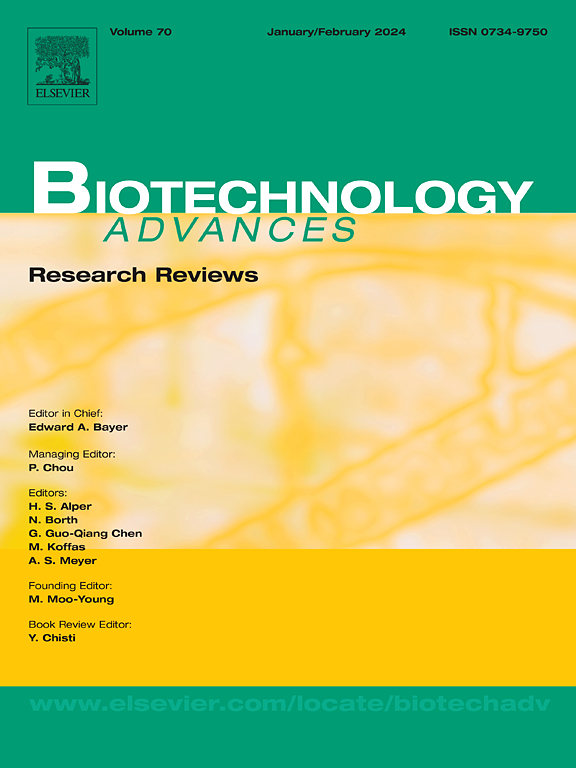Expanding the cryoprotectant toolbox in biomedicine by multifunctional antifreeze peptides
IF 12.1
1区 工程技术
Q1 BIOTECHNOLOGY & APPLIED MICROBIOLOGY
引用次数: 0
Abstract
The global cryopreservation market size rises exponentially due to increased demand for cell therapy-based products, assisted reproductive technology, and organ transplantation. Cryoprotectants (CPAs) are required to reduce ice-related damage, osmotic cell injury, and protein denaturation. Antioxidants are needed to hamper membrane lipid peroxidation under freezing stress, and antibiotics are added to the cryo-solutions to prevent contamination. The vitrification process for sized organs requires a high concentration of CPA, which is hardly achievable using conventional penetrating toxic CPAs like DMSO. Antifreeze peptides (AFpeps) are biocompatible CPAs leveraging inspiration from nature, such as freeze-tolerant and freeze-avoidant organisms, to circumvent logistic limitations in cryogenic conditions. This study aims to introduce the advances of AFpeps with cell-penetrating, antioxidant, and antimicrobial characteristics. We herein revisit the placement of AFpeps in the biobanking of cancer cells, immune cells, stem cells, blood cells, germ cells (sperms and oocytes), and probiotics. Implementing low-immunogenic AFpeps for allograft cryopreservation minimizes HLA mismatching risk after organ transplantation. Applying AFpeps to formulate bioinks with optimal rheology in extrusion-based 3D cryobiopriners expedites the bench-to-beside transition of bioprinted scaffolds. This study advocates that the fine-tuned synthetic or insect-derived AFpeps, forming round blunt-shape crystals, are biomedically broad-spectrum, and cell-permeable AFpeps from marine and plant sources, which result in sharp ice crystals, are appropriate for cryosurgery. Perspectives of the available room for developing peptide mimetics in favor of higher activity and stability and peptide-functionalized nanoparticles for enhanced delivery are delineated. Finally, antitumor immune activation by cryoimmunotherapy as an autologous in-vivo tumor lysate vaccine has been illustrated.

多功能抗冻肽扩展了生物医学领域的冷冻保护剂工具箱。
由于对基于细胞治疗的产品、辅助生殖技术和器官移植的需求增加,全球冷冻保存市场规模呈指数级增长。低温保护剂(cpa)是减少冰相关损伤、渗透细胞损伤和蛋白质变性所必需的。在冷冻胁迫下,需要抗氧化剂来阻止膜脂过氧化,并在冷冻溶液中添加抗生素来防止污染。大型器官的玻璃化过程需要高浓度的CPA,这很难用传统的穿透性有毒CPA如DMSO来实现。抗冻肽(AFpeps)是一种生物相容性cpa,利用来自大自然的灵感,如抗冻和避冻生物,以规避低温条件下的物流限制。本研究旨在介绍具有细胞穿透性、抗氧化性和抗菌性的AFpeps的研究进展。我们在此重新探讨了在癌细胞、免疫细胞、干细胞、血细胞、生殖细胞(精子和卵母细胞)和益生菌的生物库中放置AFpeps的问题。在器官移植后低温保存中使用低免疫原性AFpeps可将HLA错配风险降至最低。在基于挤压的3D低温生物打印设备中,应用AFpeps来配制具有最佳流变性的生物墨水,加快了生物打印支架从工作台到旁边的过渡。本研究认为,经过微调的合成或昆虫来源的AFpeps,形成圆形的钝状晶体,具有生物医学广谱性,并且来自海洋和植物的AFpeps可渗透细胞,形成尖锐的冰晶,适合冷冻手术。展望了开发具有更高活性和稳定性的肽模拟物以及用于增强递送的肽功能化纳米颗粒的可用空间。最后,冷冻免疫治疗作为自体体内肿瘤裂解物疫苗的抗肿瘤免疫激活已被证实。
本文章由计算机程序翻译,如有差异,请以英文原文为准。
求助全文
约1分钟内获得全文
求助全文
来源期刊

Biotechnology advances
工程技术-生物工程与应用微生物
CiteScore
25.50
自引率
2.50%
发文量
167
审稿时长
37 days
期刊介绍:
Biotechnology Advances is a comprehensive review journal that covers all aspects of the multidisciplinary field of biotechnology. The journal focuses on biotechnology principles and their applications in various industries, agriculture, medicine, environmental concerns, and regulatory issues. It publishes authoritative articles that highlight current developments and future trends in the field of biotechnology. The journal invites submissions of manuscripts that are relevant and appropriate. It targets a wide audience, including scientists, engineers, students, instructors, researchers, practitioners, managers, governments, and other stakeholders in the field. Additionally, special issues are published based on selected presentations from recent relevant conferences in collaboration with the organizations hosting those conferences.
 求助内容:
求助内容: 应助结果提醒方式:
应助结果提醒方式:


